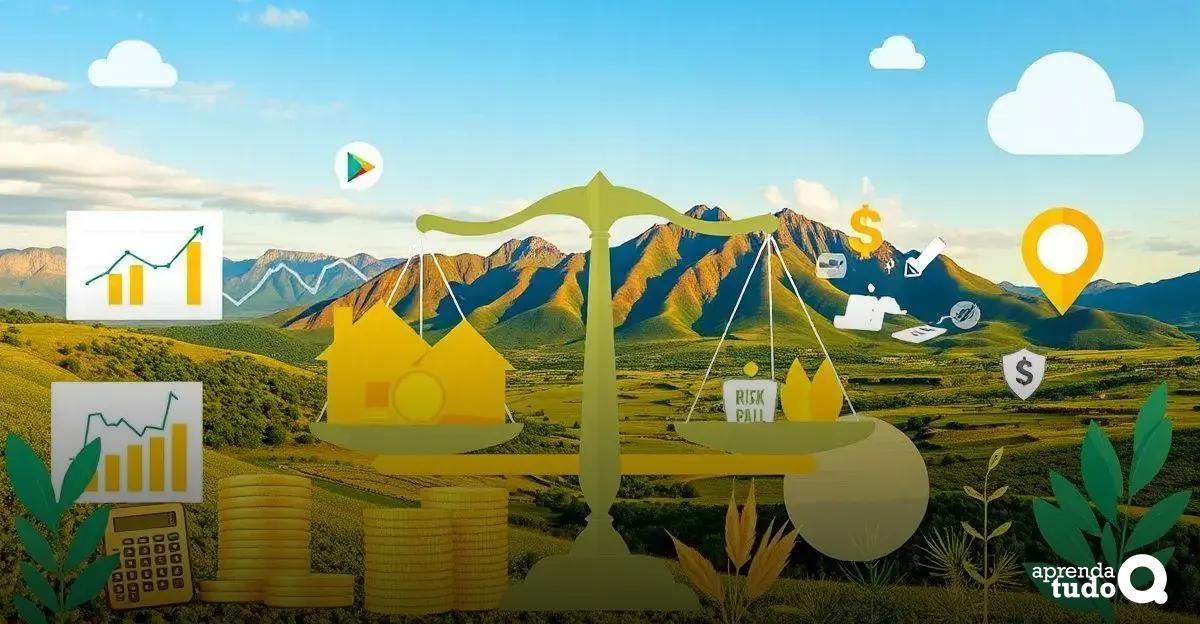Looking to boost your income? High yield investments in South Africa offer promising opportunities for savvy investors.
From real estate to high-yield debt options, there’s a range of choices.
In this guide, we’ll delve into the various types of investments that can deliver substantial returns while highlighting the risks involved.
Whether you’re a seasoned investor or just starting out, understanding these options is key to enhancing your portfolio.
Understanding High Yield Investments
Understanding high yield investments is crucial for anyone looking to enhance their wealth. But what exactly does it mean? Simply put, high yield investments are financial instruments that offer a higher rate of return compared to standard investments like savings accounts or government bonds. This higher return often comes with a trade-off – an increased level of risk.
Now, you may wonder why these investments have become popular in South Africa. With traditional savings rates often falling short of inflation, many investors are on the hunt for options that not only keep pace but outperform rising costs. High yield investments can include stocks, bonds, real estate, or even peer-to-peer lending platforms.
For example, South African corporate bonds often offer lucrative interest rates, sometimes exceeding 8% per annum. These can be appealing, especially when you consider that government bonds might barely reach half of that. However, as you can guess, the risk associated with corporate bonds is higher. Companies can default, affecting the returns you anticipated.
Another avenue is equities or stocks. Investing in shares of companies that are poised for growth could yield impressive returns. The Johannesburg Stock Exchange (JSE), for instance, has seen stocks rise considerably over the past decade – yet, with volatility comes the potential for losses.
Always remember, though, that diversifying your portfolio can help mitigate some of the risk while still allowing you to chase those enticing high yields. By spreading your investments across different sectors and instruments, you can safeguard against poor performance in any single area. So, as you explore high yield investments, weigh the potential gains against the risks, and strategize wisely!
Top Investment Options for High Returns

When it comes to top investment options for high returns in South Africa, several avenues stand out. Each of these options carries its unique risk and reward profile, so let’s explore them.
1. Real Estate Investment: Investing in property is a favourite among South Africans. Rental properties, especially in high-demand areas, can generate substantial income. Moreover, property values tend to appreciate over time, giving you both income and capital growth. Consider exploring residential properties or commercial spaces for even higher returns.
2. Equity Markets: The Johannesburg Stock Exchange (JSE) is bustling with opportunities. Investing in shares of companies that exhibit strong growth potential can yield impressive returns. Look for sectors on the rise, like tech or green energy, which can provide significant upswings. Just be prepared for some volatility – stock prices can fluctuate!
3. Unit Trusts: For those hesitant about picking individual stocks, unit trusts can be an excellent choice. These funds pool money from several investors to purchase a diversified portfolio of stocks or bonds. Many unit trusts in South Africa focus on high yielding assets, allowing you to benefit from expert management and diversified exposure.
4. Dividend Stocks: Stocks that pay dividends can offer a steady income stream, in addition to potential capital gain. Companies that are mature and stable, like those in the consumer goods or utilities sector, often distribute a portion of their profits as dividends. This can be a smart way to achieve high yields consistently.
5. Peer-to-Peer Lending: Platforms like RainFin have made peer-to-peer lending accessible. By lending your money directly to individuals or small businesses, you can earn higher interest rates than traditional banks offer. However, it’s crucial to assess the creditworthiness of borrowers since this involves risk.
6. High-Yield Bonds: While investing in corporate bonds can be risky, many companies offer higher yields to attract investors. Look for established firms with a track record of stable earnings to mitigate potential bad debts.
7. Cryptocurrency: Although highly volatile, investing in cryptocurrencies like Bitcoin or Ethereum has been known to deliver staggering returns. However, it’s essential to conduct thorough research or consult a financial adviser since the market can be unpredictable.
As you consider these options, it’s vital to assess your risk tolerance and investment goals. Diversifying your investments across several avenues can cushion against potential losses while chasing those desirable high returns!
Risk vs. Reward in High Yield Investments
When diving into risk vs. reward in high yield investments, it’s essential to understand the delicate balance that exists between these two factors. The allure of high returns often comes hand in hand with increased risk. So, what does this mean for investors in South Africa?
First off, it’s important to define what we mean by ‘risk.’ In investment terms, risk refers to the possibility of losing money or not achieving the expected return. High yield investments typically involve assets that have a higher chance of volatility and fluctuations in price. For instance, investing in small-cap stocks can yield high returns, but these stocks are often more susceptible to market changes and economic downturns.
On the reward side, the potential returns from high yield investments can be significantly higher than those from traditional investments such as fixed deposits or government bonds. For example, investing in a high-performing JSE stock could yield returns in excess of 20%, which is substantially higher than the paltry interest rates offered by banks. This potential for significant gains is what drives many investors to seek out high yield opportunities.
However, understanding the risk associated with these potential rewards is paramount. Take, for example, real estate investments: while the property market can be lucrative, it is also subject to economic factors such as interest rates and market demand. A downturn can diminish property values, resulting in losses for investors. Similarly, in the arena of high-yield bonds, while the interest rates may appear attractive, the risk of default or financial instability in the issuing company can lead to severe losses.
Moreover, assessing personal risk tolerance is crucial. How much risk are you willing to take for the chance at higher returns? Younger investors might be more inclined to take risks, as they have time to recover from potential losses. On the other hand, those nearing retirement may prefer safer, more stable options to preserve capital.
One strategy to manage risk is through diversification – sprinkling a variety of high yield investments across your portfolio. This can help mitigate the impact of a poor performing asset on your overall investment strategy. In essence, it’s about not putting all your eggs in one basket!
At the end of the day, navigating the risk-reward spectrum in high yield investments requires careful consideration and planning. Educating yourself about the types of investments you’re interested in, understanding market trends, and assessing your personal financial situation can all aid in making informed decisions. As with any investment, weighing these factors carefully can help you balance your portfolio towards achieving those attractive high yields!
How to Choose the Right Investment

Choosing the right investment can feel daunting, especially with so many options available in the realm of high yield investments. However, with a structured approach, you can make decisions that align with your financial goals. Here are some key steps to guide you through the process.
1. Define Your Investment Goals: Before diving into any investment, take a moment to define what you want to achieve. Are you aiming for short-term gains, or are you looking to build wealth over the long haul? Perhaps you wish to generate passive income through rental properties or dividend stocks. Understanding your goals will help narrow down your options.
2. Assess Your Risk Tolerance: Different people have different appetites for risk. Some may be comfortable with volatile investments that have the potential for high returns, while others may prefer safer options that yield moderate growth. Evaluate how much risk you are willing to take based on your financial situation and peace of mind.
3. Research Investment Options: With your goals and risk tolerance in mind, start researching various investment avenues. Look into real estate, stocks, bonds, with an emphasis on their historical performance and current market trends. Resources like financial news websites, investment blogs, and economic reports can provide essential insights.
4. Consider the Time Horizon: How long can you commit to your investments? A longer time horizon often provides the luxury of riding out market fluctuations, allowing for greater risk-taking. Conversely, if you might need liquidity in the short term, you might opt for investments that are less risky.
5. Diversification is Key: As previously mentioned, diversifying across various assets can mitigate your risk. Consider a blend of stocks, bonds, and real estate or any combination that makes sense for you. Not only does this strategy help safeguard against poor performance in a single asset class, but it can also enhance your chances for overall positive returns.
6. Seek Professional Advice: If navigating the investment landscape feels overwhelming, don’t hesitate to seek help from financial advisers or investment professionals. They can provide tailored guidance based on your unique circumstances and assist you in creating a well-rounded investment strategy.
7. Monitor and Adjust: Finally, investing isn’t a set-it-and-forget-it process. Regularly review your portfolio’s performance and stay informed about market conditions. Don’t be afraid to make adjustments along the way based on changing circumstances or shifts in your investment goals.
Remember, the journey to choosing the right investment is personal and varies for every individual. By thoughtfully assessing your goals, risk tolerance, and market options, you can set yourself on a path toward achieving high yield returns while minimising potential downsides.
Tax Implications of High Yield Investments
One often overlooked aspect of investing is the tax implications of high yield investments. Understanding how your investments will be taxed can significantly affect your overall returns, so it’s essential to be informed before you dive into high yield opportunities.
In South Africa, different types of investments are taxed differently. For instance, equity investments, like shares from the Johannesburg Stock Exchange (JSE), are subject to capital gains tax (CGT). This tax is triggered when you sell your assets for a profit. The current CGT rate can vary, but as a general rule, only a portion of your gains will be taxable, making it slightly more favorable for investors.
Next up is interest income from high yield bonds and savings accounts, which is taxed as income. This means that whatever interest you earn will be added to your taxable income and taxed at your marginal tax rate. If you’re investing in high yield fixed deposits or corporate bonds, keep this in mind, as the interest can push you into a higher tax bracket.
When it comes to property investments, rental income is also taxable. If you choose to invest in real estate, remember that the South African Revenue Service (SARS) requires you to declare your rental income when filing your taxes. However, you can offset some expenses associated with maintaining the property, such as repair costs and property management fees, against this income, reducing your taxable amount.
It’s also worth noting that dividends received from shares are subject to dividend withholding tax. While a flat rate of 20% applies to most dividends, this can differ based on tax treaties if the dividends come from foreign investments.
Understanding these tax implications ahead of time can help you make more informed investment choices. Some investors may even opt for tax-efficient investment vehicles, such as tax-free savings accounts (TFSAs), where returns earned are exempt from tax, allowing your money to grow without the tax burden.
Always keep records of your investment transactions and consult with a tax professional to ensure compliance and optimize your tax situation. The landscape of tax laws can change, and seeking expert advice will help you navigate these waters effectively. After all, taxes impact your net returns, so being proactive can help you retain as much of your hard-earned money as possible!
Setting Realistic Expectations

When it comes to investing, particularly in high yield opportunities, setting realistic expectations is crucial. It’s easy to get swept up in the idea of sky-high returns, but understanding what’s realistically achievable will help keep your financial decisions grounded.
First, it’s important to differentiate between potential returns and what has historically been achieved. Many high yield investments come with enticing advertised returns, but past performance is not always indicative of future results. For instance, while some stocks may have surged dramatically, others may have languished or even plummeted, illustrating the volatility associated with equities.
In South Africa, the average stock market return over the long term (historically around 15% per annum) provides a benchmark. However, expecting every stock in your portfolio to achieve this level can lead to disappointment. Setting a more tempered expectation, based on thorough research and past performance of specific sectors or companies, is a wiser approach.
Similarly, in the real estate market, while it’s possible to achieve substantial returns, there are numerous variables at play. Factors such as location, market conditions, and economic fluctuations all impact property values and rental incomes. It’s wise to plan for realistic occupancy rates, potential maintenance costs, and even market downturns when calculating your expected returns.
Another crucial element is the time factor. Many high yield investments require a longer time horizon to realise their full potential. If you’re investing in stocks, for example, the effects of compounding can bear fruit over time. Thus, setting expectations based on a multi-year outlook versus short-term gains can help mitigate disappointment.
It’s also vital to prepare for fluctuations in your returns. High yield investments can come with unpredictable elements that may sway results – both positively and negatively. Having a mindset that accommodates the ups and downs of investing helps buffer against the emotional stress that can accompany market changes.
Lastly, openly discussing your expectations and financial goals with a professional adviser can provide clarity and guidance. They can help frame realistic benchmarks based on your unique situation and risk tolerance, ensuring your investment journey aligns with your long-term financial objectives.
In summary, while the allure of high returns can be enticing, honing your expectations ensures a more thoughtful and informed investment approach. By focusing on sustainable, realistic goals and maintaining a long-term perspective, you’re on the right path to achieving financial success!
Resources for Further Research
For anyone interested in diving deeper into the world of high yield investments, leveraging resources for further research is key to making informed decisions. Here’s a selection of valuable resources to help you on your investment journey:
1. Financial News Websites: Keeping up with financial news is essential. Websites like Fin24, Moneyweb, and BusinessLive offer comprehensive coverage of South African financial markets, investment tips, and economic trends.
2. Investment Courses: If you’re looking to build a solid foundation in investment principles, consider enrolling in online courses. Platforms like Coursera, Udemy, and local institutions often provide courses specifically tailored to investing in South Africa.
3. Books on Investing: Educate yourself through reading. Consider titles like ‘The Intelligent Investor’ by Benjamin Graham or ‘Rich Dad Poor Dad’ by Robert Kiyosaki, which cover fundamental and advanced concepts on investing. There are also South African-focused books that discuss local markets and investment strategies.
4. Online Financial Forums: Engaging with fellow investors can provide insights and tips. Platforms like Reddit’s r/ZAFinance and local investment Facebook groups allow individuals to share experiences and ask for advice.
5. Investment Podcasts: If you prefer auditory learning, many podcasts discuss investing themes relevant to South Africa. ‘Invest Like the Best’ and ‘The Investing Podcast’ often feature expert guests and offer fresh perspectives on market trends.
6. Financial Advisors: Consulting a financial advisor can be invaluable. They can provide personalized guidance tailored to your financial goals and risk tolerance. Look for advisors with fiduciary responsibility, meaning they prioritise your interests in their investment recommendations.
7. Local Stock Exchanges: The Johannesburg Stock Exchange (JSE) has an educational section on its website, providing resources for new investors, including market performance insights and informational tutorials about stocks and bonds trades.
8. Research Reports: Many financial institutions publish research papers and investment outlooks. Firms like Standard Bank and Absa often produce regular reports that can give insights into market trends and forecasts in various investment sectors.
By engaging with these resources, you can enhance your understanding of high yield investments and better equip yourself to make informed choices. Remember, knowledge is power when it comes to investing!






